For Buyers: Reviewing the Inspection Report
Once the inspection is complete, the inspector will provide a detailed report, typically within 24 hours. This report includes:
- Photographs of areas inspected
- Descriptions of findings
- Recommendations for repairs or further evaluations
Buyers should review this report thoroughly, ideally with their real estate agent, to understand the implications of the findings. It's essential to distinguish between:
- Major issues: Structural problems, roofing issues, or safety hazards
- Minor issues: Cosmetic concerns or minor repairs
This distinction will guide the next steps in the process.
For Buyers: Deciding on Action
Based on the inspection findings, buyers have several options:
- Proceed Without Changes: If the inspection reveals no significant issues, buyers may choose to move forward with the purchase as planned.
- Request Repairs or Credits: Buyers can ask the seller to address specific issues before closing or request a credit to cover repair costs.
- Renegotiate the Purchase Price: If significant issues are found, buyers may negotiate a lower purchase price to account for anticipated repair expenses.
- Cancel the Purchase: If the inspection uncovers major problems and no agreement can be reached, buyers may decide to withdraw from the transaction, especially if an inspection contingency is in place.
For Sellers: Responding to the Inspection
Sellers should anticipate that the inspection may reveal areas needing attention. Upon receiving the buyer's requests, sellers have several options:
- Agree to Repairs: Addressing the buyer's concerns can facilitate a smoother transaction and demonstrate goodwill.
- Offer a Credit: Instead of making repairs, sellers might offer a credit at closing, allowing buyers to handle repairs post-purchase.
- Decline to Make Changes: In some cases, sellers may choose not to address the issues. However, this can lead to renegotiations or potential cancellation of the deal.
It's crucial for sellers to consult with their real estate agent to determine the best course of action based on the market conditions and the severity of the issues.
Negotiation Tips for Both Parties
Effective communication and negotiation are key to resolving post-inspection concerns:
- Be Reasonable: Focus on significant issues that impact the property's value or safety rather than minor cosmetic concerns.
- Get Estimates: Obtain repair estimates to understand the potential costs involved.
- Stay Flexible: Be open to compromises, such as offering credits instead of making repairs.
- Document Agreements: Ensure all agreements are documented in writing to avoid misunderstandings.
Finalizing the Deal
Once both parties reach an agreement, the transaction moves forward:
- Schedule Repairs: If repairs are agreed upon, schedule them promptly to avoid delays.
- Final Walk-Through: Buyers typically conduct a final walk-through to ensure agreed-upon repairs have been made and the property is in the expected condition.
- Closing: All parties meet to sign the necessary documents, and ownership of the property is transferred to the buyer.
Conclusion
The period following a home inspection is a critical phase in the real estate transaction process. By understanding the steps involved and maintaining open communication, both buyers and sellers can navigate this phase effectively, leading to a successful closing.
Schedule your professional home inspection with Lemonade Home Inspections today and gain the confidence to move forward with your property transaction safely and efficiently.




